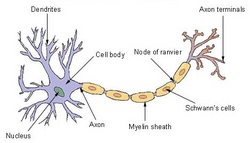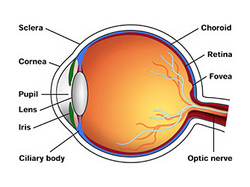Chapter 21
The Nervous System

Courtesy of The Encyclopedia of Science
Any internal or external change that brings about a response is called a stimulus. Your body can adjust to these stimuli with help from the nervous system.
Neurons are nerve cells. They have a cell body, dendrites, and axons. Dendrites receive impulses (messages carried by neurons) from other neurons. Axons carry impulses to other neurons, muscles, or glands.
There are three types of nerve cells: sensory neurons, interneurons, and motor neurons. Sensory neurons receive information and send it to the brain or spinal cord. Here, interneurons interpret the information and send it to motor neurons. The motor neurons conduct the impulses to muscles or glands.
Impulses need to move from neuron to neuron. To do this, though, the impulses have to pass through spaces between axons in one neuron and dendrites in the other. This space is called a synapse.
There are two sections to the nervous system in your body. They are the central (CNS) and peripheral (PNS) nervous systems. The CNS consists of the brain and spinal cord. The PNS consists of nerves connecting the brain and spinal cord.
The brain is the control center of the body. It decides almost everything your body does. There are three parts to it: the cerebrum, cerebellum, and brain stem. The cerebrum deals with thinking. The cerebellum deals with balance and coordination. The brain stem leads into the spinal cord and controls involuntary actions like breathing and heart beat.
The spinal cord comes down from the brain stem. It carries impulses to and from the brain.
A reflex is an involuntary, automatic response to a stimulus. Think about putting your hand over a hot stove. Sensory receptors send an impulse to an interneuron in the spinal cord. The interneuron immediately relays the information to motor neurons in your hand. The motor neurons send the impulse to muscles in the hand, and your hand moves away from the hot stove.
Neurons are nerve cells. They have a cell body, dendrites, and axons. Dendrites receive impulses (messages carried by neurons) from other neurons. Axons carry impulses to other neurons, muscles, or glands.
There are three types of nerve cells: sensory neurons, interneurons, and motor neurons. Sensory neurons receive information and send it to the brain or spinal cord. Here, interneurons interpret the information and send it to motor neurons. The motor neurons conduct the impulses to muscles or glands.
Impulses need to move from neuron to neuron. To do this, though, the impulses have to pass through spaces between axons in one neuron and dendrites in the other. This space is called a synapse.
There are two sections to the nervous system in your body. They are the central (CNS) and peripheral (PNS) nervous systems. The CNS consists of the brain and spinal cord. The PNS consists of nerves connecting the brain and spinal cord.
The brain is the control center of the body. It decides almost everything your body does. There are three parts to it: the cerebrum, cerebellum, and brain stem. The cerebrum deals with thinking. The cerebellum deals with balance and coordination. The brain stem leads into the spinal cord and controls involuntary actions like breathing and heart beat.
The spinal cord comes down from the brain stem. It carries impulses to and from the brain.
A reflex is an involuntary, automatic response to a stimulus. Think about putting your hand over a hot stove. Sensory receptors send an impulse to an interneuron in the spinal cord. The interneuron immediately relays the information to motor neurons in your hand. The motor neurons send the impulse to muscles in the hand, and your hand moves away from the hot stove.
The Senses

Courtesy of Medical Data for Artists
Your body has five senses: vision, hearing, smell, taste, and touch.
To see, light enters your eye and sends impulses to the optic nerve. The optic nerve carries this impulse to the brain. The brain interprets the impulse, and you see an an image. People who are nearsighted can see closer objects more clearly than distant objects. Concave lenses are used to correct this person's vision. People who are farsighted can see distant objects more clearly than nearer objects. Convex lenses are used to correct this person's vision.
To hear, you need sound waves. These waves stimulate nerve cells in the ear. Vibrations occur in various places in the ear, and you hear a noise. Parts of your ear help with your balance by reacting to movements of your body and checking the position of your head with the ground.
Molecules in the air stimulate nerve cells in the nose called olfactory cells. If there are enough molecules, an impulse is made and sent to the brain. The stimulus is then interpreted, and you smell.
Taste buds on your tongue help you taste. They respond to taste sensations like sweet and bitter. Saliva breaks down food on the tongue, and it washes over the taste buds. An impulse is formed, sent to the brain, and interpreted. Now, you taste.
Sensory receptors in your skin help you touch. They allow you to feel the difference between rough, smooth, hard, soft, and other touches like that.
To see, light enters your eye and sends impulses to the optic nerve. The optic nerve carries this impulse to the brain. The brain interprets the impulse, and you see an an image. People who are nearsighted can see closer objects more clearly than distant objects. Concave lenses are used to correct this person's vision. People who are farsighted can see distant objects more clearly than nearer objects. Convex lenses are used to correct this person's vision.
To hear, you need sound waves. These waves stimulate nerve cells in the ear. Vibrations occur in various places in the ear, and you hear a noise. Parts of your ear help with your balance by reacting to movements of your body and checking the position of your head with the ground.
Molecules in the air stimulate nerve cells in the nose called olfactory cells. If there are enough molecules, an impulse is made and sent to the brain. The stimulus is then interpreted, and you smell.
Taste buds on your tongue help you taste. They respond to taste sensations like sweet and bitter. Saliva breaks down food on the tongue, and it washes over the taste buds. An impulse is formed, sent to the brain, and interpreted. Now, you taste.
Sensory receptors in your skin help you touch. They allow you to feel the difference between rough, smooth, hard, soft, and other touches like that.


